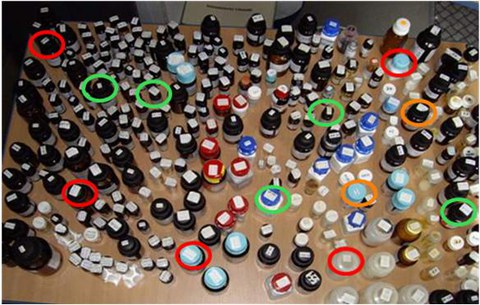Ionische Flüssigkeiten
Ionic Liquids (ILs) are salts with melting points below 100 °C that are formed solely by cations and anions, one or both of which are weakly coordinating ions. In recent years ILs have attracted considerable interest, which has led to an impressive number of > 500 000 publications, including more than 10 000 patents.
The burgeoning number of publications and the still increasing interest in ILs are mainly due to the physicochemical properties of ILs, for instance, their often high electrochemical and thermal stability, wide range of viscosity, low vapour pressure, and favourable solvation capabilities.
These properties make them interesting in different fields of research and application. Nowadays they have been used in small-scale to pilot-plant and large-scale industrial applications. The combinability of their different components has led to a vast number of ILs – millions of structures are theoretically accessible, several thousands have been synthesised, and a few hundred are commercially available. The structural variability permits systematic investigations and a structural design allowing the adaptation of ILs with improved property profiles for certain applications.
Our research aims to design ILs that combine an optimal technological performance as well as a low hazard potential towards human and the environment.
The outcome of our research can be summarized as follows:
- more than 400 different ionic liquids investigated in terms of (ecotoxicity) and biodegradability
- QSAR models predicting properties could be established
- methods for the removal of ILs from wastewater could be achieved (via recovery or advanced oxidation processes
- around 50 peer-reviewed papers, and > 2000 citations during the last 10 years
- around 15 (inter)national talks, and more than 20 poster presentations
- 10 third-party funded research projects (DBU, DFG, BMBF, Industry)
From our research we know now that he design of inherently safer ionic liquids with a reduced hazard for man and the environment and with required physico-chemical properties is – with certain restrictions - feasible.
If you want to read more about this topic:
Dołżonek J., Cho C.-W., Stepnowski P., Markiewicz M.,Thöming J., and Stolte S. (2017) Membrane partitioning of ionic liquid cations, anions and ion pairs – estimating the bioconcentration potential of organic ions. Environmental Pollution 228, 379-389.
Neumann et al. (2014) Biodegradability of 27 pyrrolidinium, morpholinium, piperidinium, imidazolium and pyridinium ionic liquid cations under aerobic conditions. Green Chemistry 16, 2174–2184. Open Access
Stolte et al. (2012) Ionic liquids as lubricants or lubrication additives: an ecotoxicity and biodegradability assessment. Chemosphere 89(9), 1135-1141. Free full text available under: ResearchGate
Ranke et al. (2007). Design of sustainable chemical products - the example of ionic liquids. Chemical Reviews 107, 2183-2208.
Contact: Prof. Stefan Stolte

